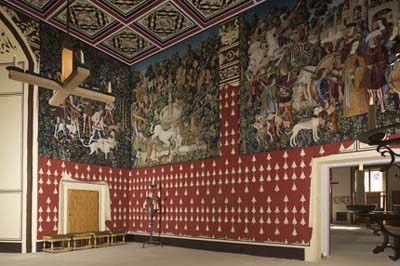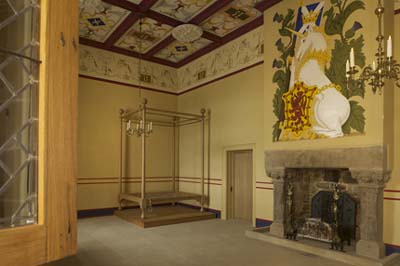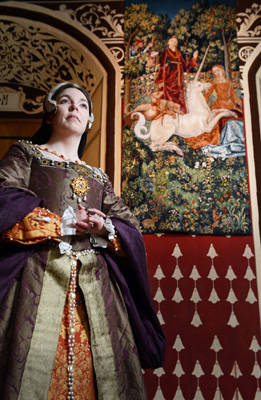

The Palace at Stirling Castle allows visitors to step into the astonishing richness of royal life in the 1500s. James V's Palace at Stirling is one of the finest and best-preserved Renaissance buildings in Great Britain. Following a major programme of research and re-presentation, it can now be seen by visitors much as it may have looked on completion around 1545.
The decoration of the Palace's six main rooms is overwhelmingly colourful, rich and elaborate. James and his French wife Mary of Guise aimed to present themselves as wealthy, learned and sophisticated. The decorative style belongs to the Renaissance - a great flowering in arts, literature and philosophy that revolutionised Europe in the 1400s and 1500s. Bright colours, expensive fabrics and ornate patterns were essential elements.
In 1538, James was preparing to marry his second French wife. To mark the arrival of his bride, James commissioned a new Palace in Stirling Castle. It was intended to be as fine as any princely residence she would have known in the richer kingdom of France.
The Palace was designed to display James V's wealth, learning and sophistication, as well as asserting his right to rule. Its elaborate decorative scheme, inside and out, was inspired by the European Renaissance. It draws on ideas from the Classical world, employing elaborate symbols and motifs to broadcast messages of power and prosperity, wisdom and justice. Interiors and exteriors would have been painted in bright colours, with plentiful gilding

The Palace comprises Royal Lodgings for the king and queen. Each apartment has three spacious rooms - in ascending order of privacy: an Outer Hall, an Inner Hall and a Bedchamber. Access to these rooms was restricted according to the importance of the visitor and the royal privilege extended to them. The king's and queen's suites are on the same floor, arranged around a courtyard known as the Lion's Den. These rooms were used for a variety of purposes, including taking meals, greeting important visitors, dancing and entertainments, royal audiences and meetings about affairs of state. But the bedchambers were rarely used for sleeping. The king and queen slept in small private chambers known as closets.
The Royal Lodgings have now been returned to something approaching their former glory. A major programme of research and re-presentation, lasting 10 years and costing £12 million, was completed in summer 2011. Visitors can now glimpse life in one of the great royal residences of Scotland's kings and queens. The decorative scheme is amazingly elaborate and colourful. It includes hand-woven tapestries, superb, hand-made furniture and painted replicas of the famous Stirling Heads - carved portraits in oak that once adorned the ceiling of James V's magnificent Palace.

A 14 year project to recreate the lost tapestries of James V has been completed at Stirling Castle.
The final tapestry in the series The Mystic Hunt of the Unicorn woven by Master Weavers from West Dean Tapestry Studio was unveiled at Stirling Castle on 23rd June 2015 marking the culmination of the biggest tapestry project undertaken in the UK in the last 100 years. The project was commissioned by Historic Scotland in 2001 as part of a wider project to restore the interiors of the palace of James V to how they may have looked in the 1540s, when it was home to James' wife Mary of Guise and their young daughter, Mary, Queen of Scots.
It was known from royal inventories that when James V built the palace he owned over 100 tapestries, but there is no record of what happened to them. The inventories, however, described a set of tapestries depicting "the historie of the unicorne".
The team began extensive research which took them to the United States, and to the Metropolitan Museum of Art in New York, which is home to a set of seven 15th century Flemish tapestries "The Hunt of the Unicorn". The result was a 14 year project to reinterpret and create the "Hunt of the Unicorn" tapestries, bringing together 18 weavers from across the globe.
Now for the first time visitors will be able to see all seven tapestries together, marking the final chapter in the journey to recreate the palace of James V.
Commenting on the completion of the project, Fiona Hyslop, Cabinet Secretary for Culture, Europe and External Affairs, said, "It's wonderful that the Stirling Tapestry project has now been completed after more than a decade of hard work and painstaking research. The installation of the final tapestry marks the final element of a wider project to refurbish the interiors of the palace to how they may have looked in the 1540s. I hope visitors to the castle will take the opportunity to enjoy the craftsmanship and skill behind these magnificent tapestries, which have brought together a global team to help tell the story of one of Scotland's most magnificent palaces."
Peter Buchanan, Project Manager for Historic Scotland, who oversaw the project from its inception to completion said, "It has been a privilege to watch these talented weavers painstakingly recreate the tapestries in all their Renaissance glory. Whilst we may never know what happened to the original tapestries, the fact that we now have these fantastic recreations, with the assistance of the Met in New York and through the generosity of our donors, will provide visitors to the castle now and for generations to come with a real insight into how the palace may have been at the time of James V."
"The completion of the last tapestry, The Mystic Hunt of the Unicorn, was all the more impressive by the fact that only two fragments of the original remain in New York. Through extensive research, Katharine Swailes, West Dean Tapestry Master Weaver, and Designer and Weaver Ruth Jones were able to build up a picture of how the panel might have looked originally and it's thrilling to see the end result hanging in the palace with the rest of the series, marking the final step in a fourteen year journey."
The Stirling Tapestry project was funded through donations to the Historic Scotland Foundation. The main donor organisation was the Quinque Foundation of America, with contributions from many other organisations, friends of Historic Scotland and visitors to the Tapestry Studio at the Castle. Weaving was carried out by a team from West Dean Tapestry Studio, who were commissioned to design and weave all seven tapestries.
Weaving took place both at West Dean, near Chichester and on site at a specially commissioned studio at the castle. The onsite weaving saw visitors return to the tapestry studio to watch the weaver's progress over the duration of the project. The space has now been converted into a temporary exhibition, Weaving The Unicorn charting the weavers' story.
The final tapestry will be on display to the public, along with the other six in the series. To view a video about the project please visit https://youtu.be/cBO9DmySARM
There's more than ever to see and do at Stirling Castle
Open all year, seven days a week.
1 April - 30 September
Mon Tue Wed Thu Fri Sat Sun
9.30 am to 6.00 pm
1 October - 31 March
Mon Tue Wed Thu Fri Sat Sun
9.30 am to 5.00 pm
Last ticket sold 45 minutes before closing (regimental museum closes 45 mins before castle).
Car parking and Coach parking
toilets
restaurant
gift
shop
book shop
reasonable wheelchair access
toilets for disabled visitors
Stirling Castle is rated a 5-star visitor attraction Argyll's Lodging a 4-star by VisitScotland.
The Stirling Castle admission ticket also gives access to Argyll's Lodging (access by guided tour only - enquire at Stirling Castle on 01786 450 000).
Stirling Castle will be closed on Christmas Day and Boxing day.
Stirling Castle
Castle Wynd
Stirling Old Town
Stirling FK8 1EJ
Tel: 01786 450000
All information in this article was provided by Historic Scotland.